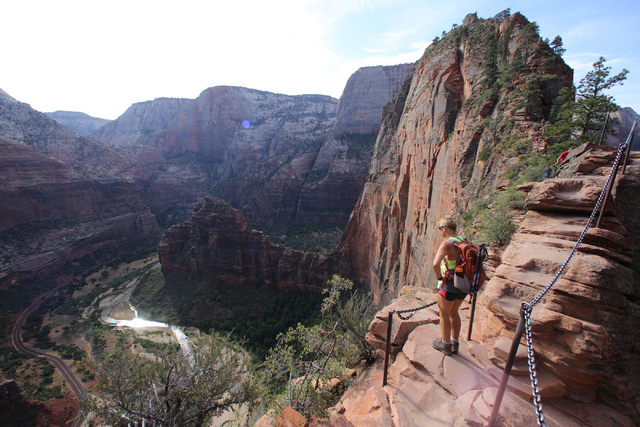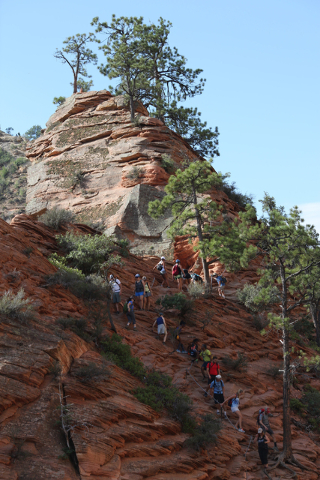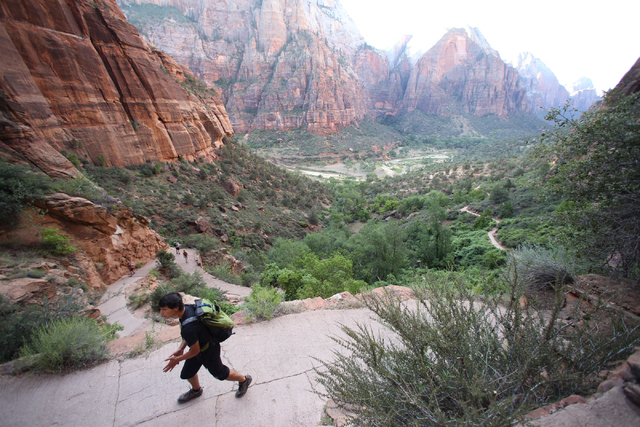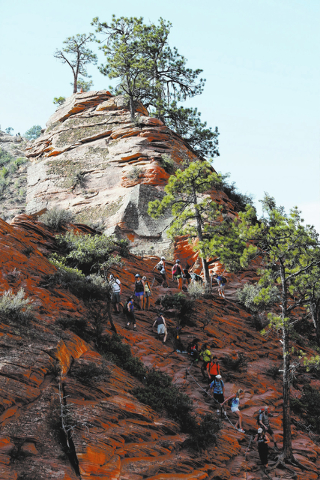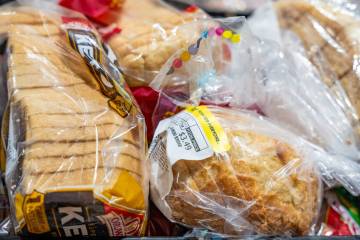Angels Landing Trail in Zion National Park not for the weak of heart
In a crowded Zion National Park shuttle, I winced as I gulped hot coffee before my first hike early July 30.
I was bound for Angels Landing, the 5-mile round trip trail that starts beside the Virgin River and shoots up another 1,500 feet to the final, panoramic viewpoint. The park describes the hike as “strenuous,” and at least five people have died on the trail, which features steep drop-offs and narrow walkways for the last half-mile.
The shuttle wobbled and swayed as we crawled into the canyon just after sunrise. I tried to keep my balance as I looked up at the cliffs and canyons above me, then took a deep breath and asked my coffee to kick in faster.
PLANNING AHEAD
Nearly two hours earlier I was stretching awake in my nearby Springdale, Utah, hotel room. And at 5:45 a.m., I thought I’d woken up early enough.
The night before, I’d packed up my things and put them in my car, since I wouldn’t be back before checkout.
For my hike, I set aside separate clothes, my boots, my wallet and my pack. In the hotel’s mini-fridge, I chilled six water bottles I planned to take with me, along with a microwaveable breakfast sandwich.
In bed that night, I felt set. I estimated I’d take about 30 minutes to walk out the door the next day, then excitedly fell asleep.
But it was a slow start. And the coffee I was clinging to on the shuttle took about 20 minutes to get after a long cafe line just outside the park.
Looking back, I should have realized I’d need a to-go cup to take my hotel coffee to the canyon, or saved myself an energy drink. I also should’ve respected how crowded the park can get — even at 7 a.m. — on a summer Saturday.
CROWD CONTROL
As the shuttle slowed to a stop at The Grotto, where the Angels Landing trailhead sits, I silently hoped I’d be the only one to hop off here. But when the doors opened, about 30 other people stumbled out, too.
In an attempt to avoid the crowd (and accidents on the trail), I opted to use the restroom near the shuttle stop as the others walked toward the river to begin. Without them as my witness, I felt more comfortable wheezing up the canyon in relative privacy, since I’m not a picture of cardiovascular health.
With a bathroom behind me and the peak of Angels Landing jutting up in front of me, I started. It was pleasant at first; the dirt trail winds past the flowing, bubbling river, and in the morning, you’re shaded well.
Birds chirped as my boots clopped beneath me, and with each easy step, I thought, “I can do this.”
Before you know it, the dirt trail becomes paved. Switchbacks also begin — a sign of the soon-to-be rapid climb in elevation, and a sign I should take my first water break.
It was beautiful — the cool morning air, the quietness of the canyon, the sweat starting to bead on my forehead.
I felt productive and athletic and proud.
A few water breaks later and a few hundred feet up in elevation, though, I started to taste my sausage breakfast sandwich again. No sip of water would rid me of the taste, and suddenly I felt it sloshing around in my stomach, too.
“You will not throw up,” I told myself.
I also told myself to opt for a granola bar or yogurt in the morning next time. And I carried on.
NEAR THE PEAK
For some hikers, Walter’s Wiggles is hell on Earth. But for me, the sight of the 21 steep switchbacks was a welcome relief.
They are the last hurdle before reaching Scout Lookout, a common snack spot with jaw-dropping views of its own. Then it’s a short scramble to the Angels Landing peak.
I didn’t do all the switchbacks at once; I stopped three or four times. But they didn’t last long, and once I reached the top, I realized where all the hikers who left me behind at the Grotto restroom ended up.
Some were lying down, soaking up the sunlight and enjoying a brief, well-deserved rest. Others pointed out the many chipmunks scurrying by, who were hoping to snag an unsuspecting hiker’s snack.
This is a good place to stop if you are afraid of heights. You can still see the scope of how far you’ve come, as tiny shuttles wind through the canyon far, far below. But the spot is also wide and flat, a safe haven before the narrow peak trail Angels Landing is known for.
DEEP BREATHS
If you plan to continue toward the peak, make sure you are aware of your limits and mentally prepared to move forward.
It starts easy. The ground around you narrows, and the walk becomes a climb. But soon, the chains drilled into the cliff can feel necessary, and for some, fear sets in.
I wasn’t particularly scared, since heights have never bothered me, but the amount of people trying to complete Angels Landing just as I was made me nervous.
On the trail, everyone moves single-file, so if you’re slow, you’re at the mercy of the people behind you — they’ll either be supportive, if you’re lucky, or annoyed.
Some will try to make a pass, something that’s terrifying yet just barely possible on the trail, which is less than 3-feet wide in some spots.
Without compromising your stability or safety, let them slide by. It’s not worth calling them out 1,500 feet up.
As you crawl and slide and scramble on, think about each move. I have a weak knee, and at one point, when I confidently stepped down to the rock a few feet below me on the trail, my knee popped.
I paused. All my weight was on my now-popped knee. If I tried to adjust, it would be even more excruciating. And if I lost my balance, I’d plummet off the edge.
Deep breaths.
If I didn’t move, I’d hold up everyone behind me, so I calmly, simply said, “I’m stuck.”
With my luck, the two people behind me were sweet, and they carefully walked around me, then lifted me forward so I could adjust my weight. Once my kneecap slid back into place, the two ensured I was OK to continue.
I was, and before I could get their names, they happily continued on.
THE TOP
It is hard to describe the top of Angels Landing, because it’s more than a view. It is a feeling of accomplishment, too.
Don’t let the victory selfies fool you: The trail is hard, especially for people who don’t hike often. And the last part is treacherous.
But it is doable. And the awe of seeing the entire canyon before you is so satisfying, it makes the crowded trail behind you worth every second.
“It’s brilliant,” said Petita Abblitt, a 63-year-old woman who’d traveled from Australia to complete the hike. “This is just a ‘wow’ place. No other word for it.”
Be sure to rest up before the hike down, though; it works a whole different muscle group. And by the time you turn around, it will be later in the day, which means most of the return trip is under bright sunlight, so pack extra sunscreen.
The hike typically takes four to five hours, but it can take about six depending on breaks and physical capability. If you finish Angels Landing early enough, though, you may get a second wind like I did and try to squeeze in another hike before you leave, since Las Vegas is only about 2.5 hours away.
I opted for the Narrows, though I only stomped and splashed up-river about two miles before deciding to turn back for the day.
On the way back toward the shuttle, toward my car, toward home that afternoon, Abblitt, the woman I’d shared a moment with earlier on Angels Landing, drudged forward.
I waved, hoping to share another moment with the friendly woman. And she waved back.
Contact Rachel Crosby at rcrosby@reviewjournal.com or 702-387-5290. Find @rachelacrosby on Twitter.
If you go
Directions: The 160-mile drive takes about 2.5 hours via Interstate 15 to Utah State Highway 9 East.
Lodging: Zion National Park has three campgrounds — two within the park, one about an hour away (435-772-3256). A variety of hotels lie within Springdale, Utah, the small town just outside of the canyon, including Desert Pearl Inn, 707 Zion – Mount Carmel Highway (435-772-8888) and Cliffrose Lodge & Gardens, 281 Zion – Mount Carmel Highway (800-243-8824).
Dining: Springdale also offers several dining options, such as Zion Pizza & Noodle Co., 868 Zion – Mount Carmel Highway (435-772-3815); Bit & Spur Restaurant & Saloon, 1212 Zion – Mount Carmel Highway (435-772-3498); Blondie's Diner, 736 Zion – Mount Carmel Highway (435-772-0595).
Park entrance fees: $25 per car, good for seven days; $12 per pedestrian, bicyclist or motorcyclist, good for seven days. Shuttles within the park are free.



